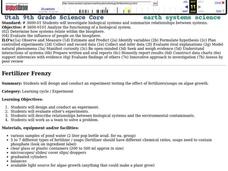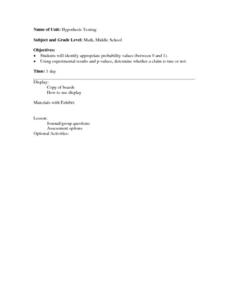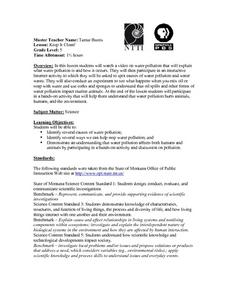US Department of Energy
Sunlight and Evaporation
Here is a simple inquiry experiment designed to demonstrate that the energy from sunlight can evaporate water. Young scientists follow provided procedural steps to construct a model of our atmosphere using a bowl, a cup, water and...
Curated OER
Introduction to the Mole
Students are introduced to the mole concept using a discovery-based method. Lesson includes activities with candy that allow students to discover the rules for mole-item, item-mole, mole-mass, and mass-mole conversions.
Curated OER
Fertilizer Frenzy
Ninth graders design and conduct an experiment. They evaluate other's experiments. Students describe relationships between biological systems and the environmental contaminants. They work as a team to solve a problem.
Curated OER
Hypothesis Testing
Students investigate the finding of a hypothesis and how it can be tested.For the experiment they will be using the concept of probability. Students design an experiment and test the hypothesis. Then the results are graphed showing the...
Curated OER
Keep It Clean!
Fifth graders investigate the how water becomes polluted and how it effects the environment, animals, and humans. They watch a video and conduct experiments.
Curated OER
The World's Simplest Cartesian Diver
Have your class learn about buoyancy using this simple lesson. First, they bring in condiment packets and see what happens when they place it in a glass of water. Then, they use one of the packets to illustrate the concept of a Cartesian...
Curated OER
Benjamin Franklin - Master of Electricity The Kite Experiment and the Invention of the Lightning Rod
Students study Benjamin Franklin including who he was, what he invented and his experiment. In this inventive lesson students follow the steps of Ben Franklin and build a Leyden jar.
Curated OER
Chain Reaction
Young scholars study animal behavior and how it changes to its environment. In this animal lesson students design and conduct experiments.
Curated OER
Types of Marine Debris
Students conduct an experiment. In this marine debris and environment protection activity, students categorize trash into piles, predict whether these trash items will sink, float or be picked up and carried by the wind and then...
Curated OER
Exploring Beach Erosion in the Great Lakes
Fourth graders conduct an experiment. In this beach erosion lesson, 4th graders define erosion, brainstorm ways to stop erosion, view pictures and video clips of erosion, and complete an experiment that models the process of erosion.
Curated OER
The Shape of Things
Sixth graders read and discuss information regarding the shape and attributes of an eggshell. In this shape of things lesson, 6th graders gather relevant information that pertains to the incubation and formation of an eggshell. ...
Curated OER
Mixtures of Matter
Students experiment with mixtures of matter. In this matter lesson, students investigate which liquids form a solution when mixed together and which do not. Students also identify which solids can be separated from matter.
Curated OER
Snack Attack: Food Packaging Activity
Students design and create packaging material for food. For this snack attack lesson, students design a package to protect a food item from heat and water. Students consider costs of materials, design, and test the package to see if it...
Discovery Education
The Cycle of Addiction
Learners examine how families and peers influence their decision making. In this addiction lesson students study the cycle of addiction to drugs and what can be done to prevent it.
Curated OER
Bees
Students design an experiment. In this bees lesson, students research pollination and work collaboratively to discover how bees aid in pollination. Students use tomato plants and create experimental designs. Lesson adaptations...
Curated OER
Beach Life: Clam Dissection
Students investigate clams. In this clam life lesson, students conduct an experiment where they dissect clams. Students compare anatomies of humans and clams.
Curated OER
Modeling changes to Ecosystems Part 1
Students record changes in an ecosystem. In this science lesson students make a hypothesis about changes in a terrarium. They record their observations. The students conduct an experiment to test their hypothesis.
Curated OER
Surface Water and Groundwater
Students examine distribution of water and minerals. For this surface and groundwater lesson, students conduct an experiment with fresh and salt water making hypothesis and drawing conclusions about minerals.
Curated OER
Glacier Slide
Students conduct an experiment. In this glaciers lesson, students learn about glaciers and then perform an experiment to show how glaciers shape the landscape around them. Students draw a picture in their journals to...
Curated OER
Bacteria: The good, the bad, the ugly
Seventh graders conduct an experiment. In this bacteria lesson plan, 7th graders list living and nonliving things and brainstorm the characteristics they share. Students are divided into two groups where they put samples of...
Curated OER
Newton's Laws and Rocketball
Middle schoolers investigate Newton's Three Laws. In this Newton's Law lesson, students write the laws in their own words. Middle schoolers then do an experiment with a ping pong ball. Students drop the ball from a set distance and...
Curated OER
Why is The Sky Blue?
Students explore why the sky is blue. In this light lesson, students conduct an experiment using water, flashlights, and milk to test why the sky is blue. Students view a PowerPoint, take notes on their results and draw conclusions.
Curated OER
Taking in Water and Minerals
Students conduct an experiment. In this plants lesson, students conduct an experiment in order to understand how liquid passes through a plant. They use balloons suspended from the classroom ceiling.
Curated OER
Billions of Bubbles
Students conduct an experiment with bubbles. In this observation and comparison lesson, students read Bubbles, Bubbles, Everywhere and conduct an experiment where they test different kinds of liquids to see which is the best for a...

























